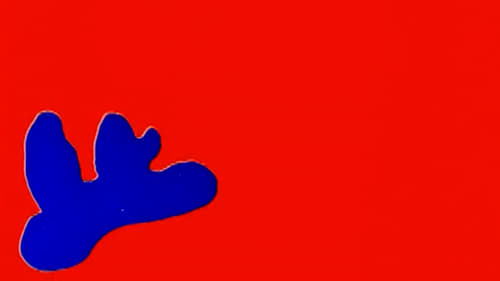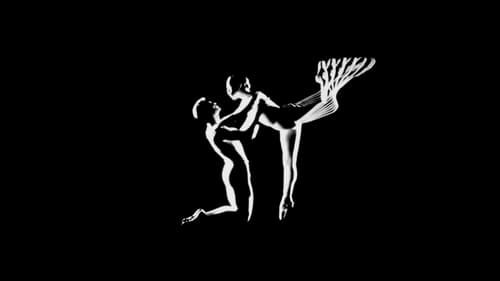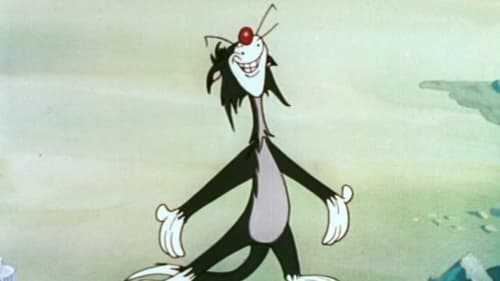Blinkity Blank (1955)
Gênero : Animação, Música
Runtime : 5M
Director : Norman McLaren
Sinopse
A playful exercise in intermittent animation and spasmodic imagery. Playing with the laws relating to persistence of vision and after-image on the retina of the eye, McLaren engraves pictures on blank film creating vivid, percussive effects.

Animated shapes dance to Cuban music. This was one of the first animations to be painted directly onto the film.

An experimental film in which both sound and visuals were created entirely by Norman McLaren drawing directly upon the film with ordinary pen and ink. The main title is in eight languages. Rereleased with multilingual titles in 1949.

An abstract film in which every motion of coloured shapes is in strict synchronization with music

A waltz played with an accordion starts a short story about the running time.

A kitten who is being tormented by a bulldog finds a savior in a black cat (from the "Black Cat Bad Luck Company") who merely has to cross the dog's path for something very unlucky to happen to the bully.

Allures is a spectacular sequence of moving figures and points, a film which reaches out to the cosmic and the spiritual, where the spatial dimension becomes transcendental.

An experimental film in which both sound and visuals were created entirely by McLaren drawing directly upon the film with ordinary pen and ink. The titles are in eight languages. Rereleased with multilingual titles in 1949.

Motion Painting No. 1 is a 1947 experimental short animated film in which film artist Oskar Fischinger put images in motion to the music of Johann Sebastian Bach’s Brandenburg Concerto no. 3, BWV 1048. It is a film of a painting (oil on acrylic glass); Fischinger filmed each brushstroke over the course of 9 months. In 1997, this film was selected for inclusion in the United States National Film Registry by the Library of Congress as being “culturally, historically, or aesthetically significant”.

James Whitney’s Lapis (1966) is a classic work of abstract cinema, a 10-minute animation that took three years to create using primitive computer equipment. In this piece smaller circles oscillate in and out in an array of colors resembling a kaleidoscope while being accompanied with Indian sitar music. The patterns become hypnotic and trance inducing. This work clearly correlates the auditory and the visual and is a wonderful example of the concept of synaesthesia.

An experimental short film of images and music made by Norman McLaren.

A work of visual art that borrows from music the principles of the fugue, with the sudden flight of a man to his hotel room as its main theme. Where he dreams.

An illustration of a traditional French Canadian song in the form of progressing cutouts and still pictures.

Rainbow Dance is a 1936 British animated film released by the GPO Film Unit. This is Lye's second film. It uses the Gasparcolor process.

Begone Dull Care shines with his masterful use of scratching and painting on film stock. In Begone Dull Care, McLaren adds complexity to Lye’s compositions, emphasising sound/visual synchronisation and generating depth on his mobile canvas. The film gives warmth and movement to compositions resembling a constantly morphing Jackson Pollock painting, yet never fails to remind us of its very calculated aesthetics when it suddenly adapts to the score’s slower movements and shifts from expressionistic and oversaturated explosions to minimalist vertical lines that vibrate accordingly to Oscar Peterson’s piano.

Two ballet dancers perform a dance enhanced with surreal after-image visuals.

A much-abused cat really hates living with people, so decides to go to the moon for some peace and quiet.

Two Penny Magic (Zweigroschenzauber) starting off with a little magic trick. It then presents an array of images from swimmers, bicyclers, murderers, airplanes in flight, boxers, lovers, runners, becoming in the end a collection of images in a magazine.

A blond and a raven-haired beauty move with verve and style through a changing landscape. The fabric of their dresses flows and floats, adding to their allure. One loses a shoe. A young man picks it up and pursues them on his bicycle.

At the center are takes which do not change - a tree in a field in Vermont, U.S.A. Since the film was shot over a period of fifty days, the single frame shots create a storm of pictures.

A free flow from photography to geometric abstraction hand-painted by Breer. - Harvard Film Archive











